Loss of office breaks Utah Diaper Bank’s growth cycle
Tom Coburn placed the last box of diapers onto the truck and slid down the rolling door. He and the rest of the Utah Diaper Bank volunteers waved as the truck starte d its journey across the Wasatch Front, where thousands of diapers would be delivered to shelters, low-income clinics, food banks and other nonprofits.
Coburn walked back into the only office of the Utah Diaper Bank, located in Sandy, Utah. Putting away scattered markers and tape, he moved some tables together in the central room of the facility. The rest of the volunteers joined him in grabbing chairs as they prepared for what always happened on the last Wednesday of the month.
When Utah Diaper Bank executive director Vic Velivis walked in with a large pot full of spaghetti and greeted everyone, Coburn knew the service dinner, part of what they called a “wrapping party,” had officially started.
As the volunteers filled their paper plates with spaghetti, Velivis reminded everyone the office wouldn’t be around once their grant from the National Diaper Bank Network ran out.
Looking around him, Coburn realized most of the volunteers in this room wouldn’t be working with the Utah Diaper Bank in a couple of months. Coburn and Velivis just had to hope a new facility or grant would materialize before their time was up.
But that never happened.
Since Coburn joined the Utah Diaper Bank in June, he knew the Sandy office was only temporary. However, when it closed in September, a cycle of growth was broken.
Velivis and Coburn hope the cycle can start anew with a more permanent location sometime in the future, but they don’t have enough money to get the infrastructure they need.
As such, they’ve hit a wall familiar to many nonprofit leaders who find that it’s a lot easier to identify a need — and people willing to volunteer their time and efforts — than it is to raise the money it takes to support such efforts.
And so, for now, they’re shifting roles, pursuing different approaches and trying to create the sort of environment in which this service can thrive once again.
Because while the nonprofit diaper game may not be glamorous work, it’s their baby.
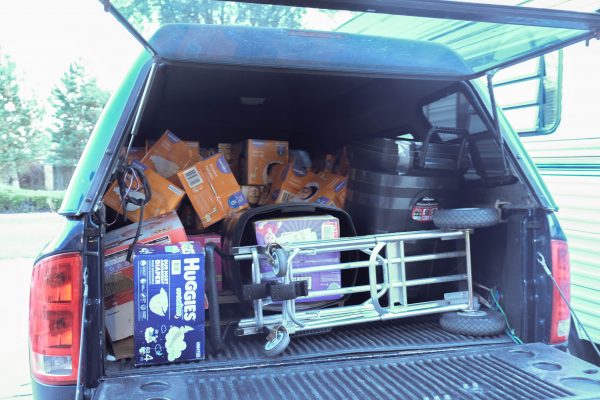
Velivis started off small, but after around four or five years, he was shipping 20,000 diapers per month out of his garage.
How the Utah Diaper Bank was born
Velivis’ original plan after retiring was to sell hot dogs at a hot dog stand. Then, in 2012, he learned Utah was one of 15 states without a diaper bank.
The diaper bank movement had begun in 1994 in Arizona. Aimed at ensuring every child in the United States could remain clean, dry and healthy, the movement grew quickly. Inspired by what others had done, Velivis discarded the hot dog idea and started a diaper bank in his garage.
Velivis started off small, but after around four or five years, he was shipping 20,000 diapers per month out of his garage. Stacks of boxes six feet tall dominated his living room and basement. People packed and wrapped diapers on his patio in the summer or in his garage during the wintertime.
An explosive year of growth came in 2018 when a warehouse donation by WEBB Production allowed the Utah Diaper Bank to increase its shipments of diapers to 300,000 per year. By the end of 2019, Velivis expects to have shipped half a million diapers across Utah.
“It’s a little more productive than a hot dog stand,” Velivis said.
The cost to rent WEBB’s warehouse, Velivis estimates, is around $120,000 per year. Yet the Utah Diaper Bank gets to use it for free.
“We have a loading dock, which makes it easier for the Utah Diaper Bank to receive shipments,” WEBB project manager Katie Krongard said. “If they want to ship a pallet of diapers, they can’t do that at Vic’s home.” According to Krongard, the warehouse is 190,000 square feet total, or more than three times bigger than a football field.
Although the bank was now doing the work of a large nonprofit, it was still running on the shoestring budget of a very small one. In September of last year, the Utah Diaper Bank received a grant from the National Diaper Bank Network, which amounted to $10,000 and was used to pay for the bank’s office in Sandy.
“That facility allowed us to begin to grow our volunteer base and gave us an operational base for pick-ups and deliveries,” Velivis said. “I knew from the beginning we wouldn’t be able to keep it, but that doesn’t mean I’m not disappointed.”
Now that the office is gone, Velivis is facing many inconveniences.
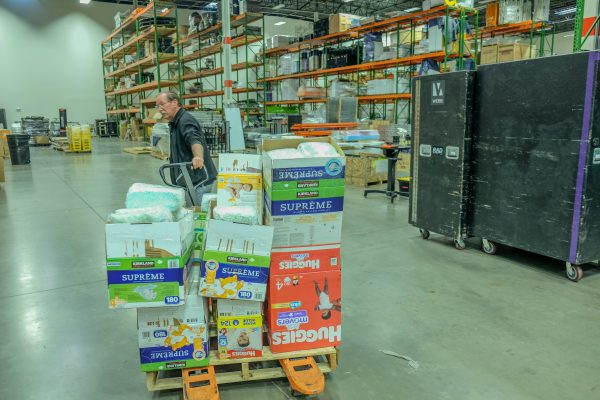
Because of the loss of infrastructure, the Utah Diaper Bank has seen a decline in volunteers.
A knot in the umbilical cord
Because of the loss of infrastructure, the Utah Diaper Bank has seen a decline in volunteers.
This, in turn, decreases the number of diapers packaged, which stretches the number of delivered diapers too thin.
“We can’t build a volunteer base without the office,” Velivis said. “People want social interaction and don’t want to wrap diapers at their homes.”
None of the employees at the Utah Diaper Bank are paid. “We can’t recruit more volunteers,” he said, “even though they’re the best way to spread awareness.”
If volunteer work were to be done for the Utah Diaper Bank, it would have to be at the WEBB warehouse. However, volunteer work in the quantity the diaper bank needs isn’t possible.
According to Velivis, most groups of volunteers want to work at night, but the warehouse closes at 5 p.m. A WEBB employee would have to stay after hours to ensure the company’s valuable equipment is safe and secure since volunteers would constantly be going in and out of the building.
Veteran nonprofit leaders are quick to point out that volunteers aren’t a substitute for stable funding.
“We get at least 550 logged volunteers a year,” Ted Chalfant said. He runs the Little Lambs Foundation for Kids, which distributes diapers, hygiene kids and comfort kits to foster children across Utah.
But even with hundreds of volunteers, “we have so many jobs that need to be filled,” Chalfant said. “With more funding, we would hire additional staff, which could help more children.”
Barbara Meldrum, who used to volunteer for the Utah Diaper Bank, misses her job. “Obviously there are other opportunities in the community, but it was a chance for me to do something other than my job as an information technology manager,” she said. “Now the work lands more on Vic.”
The shipments at the diaper bank are also impacted by the office loss.
“We’ve reached our max to support things,” Velivis said. “Working only out of the warehouse is much more time-consuming, too.”
Instead of having a central area for people to donate their time, money and diapers, Velivis and Coburn have to drive to where the donations are. They then take the results of those donations, which are usually wrapped or packaged diapers, back to the warehouse to be prepared for shipment.
The Utah Diaper Bank’s leaders are able to keep up with shipments through the help of regular volunteers and a couple WEBB employees who come in every week. Velivis has also made an agreement with the Utah Food Bank.
Since the Utah Food Bank needed diapers, and the Utah Diaper Bank needed transportation, the two organizations’ leaders agreed to help one another. The food bank got the diapers it needed, and the diaper bank got free shipping.
The Utah Diaper Bank also receives truckloads of donations from Huggies, which sponsors the National Diaper Bank Network. Velivis only pays for shipping and handling.
“Smaller programs aren’t eligible for donations from Huggies, whether it be because of warehouse space or a capacity issue,” National Diaper Bank Network chief of external affairs Troy Moore said. “Although the need for diapers is far greater than what any diaper bank can give.”
Velivis has applied for more grants like the one the National Diaper Bank Network gave him, but he hasn’t had much success. “Unless a guardian angel came with a donation, I knew the office wouldn’t stay,” he said.
So Velivis turned to a good friend of his for help.
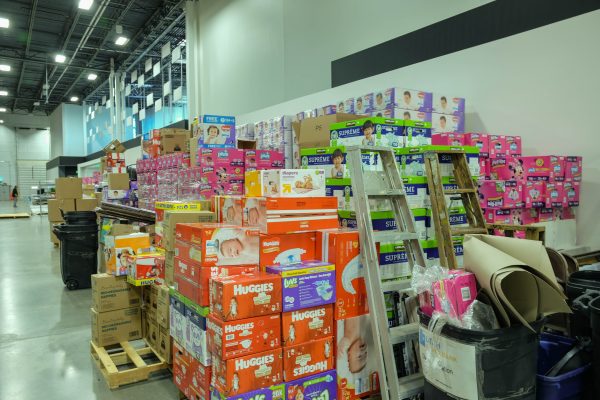
The Utah Diaper Bank also receives truckloads of donations from Huggies, which sponsors the National Diaper Bank Network.
Taking its first breath
Coburn and Velivis have been good friends for 16 years. When Coburn moved to Nevada to work for Delta Air Lines for nearly a decade, the two stayed in touch. Coburn decided to return to Utah for his retirement, so he could be around his grandchildren. Like Velivis, he wanted something to do during his time as a retiree.
“Vic told me what was going on with his Diaper Bank, and I said, ‘Wow, that’s important. I want to be part of that.’ Then Vic said, ‘Good because that’s what I’m planning,’” Coburn said.
Coburn started off as a volunteer. Gradually, Velivis showed him how the organization worked. The more Coburn saw, the more he was enticed.
Eventually, Coburn was named operations manager over the Utah Diaper Bank, due to his expertise in organization. Instead of Velivis handling shipments and, at the time, communication and administration with the volunteers at the office, Coburn handled those roles.
“Vic has a lot on his plate. I hope to alleviate some of that stress,” Coburn said.
Because of Coburn’s help, Velivis doesn’t have to oversee shipments anymore, which included packing pallets and doing deliveries. So Velivis hopes to use his newfound free time to find ways to increase the amount of the Utah Diaper Bank’s infrastructure.
“It’s hard to raise funds for infrastructure,” Velivis said. “It’s easy to get someone to give money for diapers.” He has asked many companies for $1,000 donations with no success. “I’ve got to go out again. Since Tom has free time, I should be able to do that now.”
“Funders don’t generally want to pay for infrastructure cost,” Utah Nonprofits Association chief executive officer Kate Rubalcava said. “They want you to miraculously figure out how to fix that problem.”
Rubalcava said people are compelled to give when they understand the mission of an organization. “It’s not all on the responsibility of the nonprofit, since these organizations are reliant on individual donors,” she said.
Velivis writes realtors with unused or abandoned buildings if they would be willing to donate them. “I never get a response,” he said. “I’ll keep on trying.”
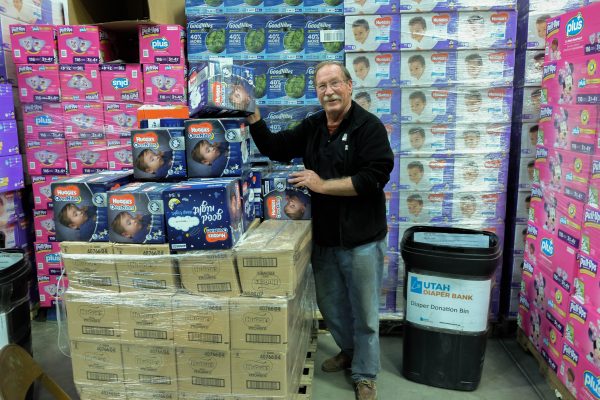
Velivis’ original plan after retiring was to sell hot dogs at a hot dog stand. Then, in 2012, he learned Utah was one of 15 states without a diaper bank.
Delayed cord clamping
Coburn and Velivis scrubbed one of the walls of what had once been the Sandy office of the Utah Diaper Bank. The last few things of the office had just been taken out. Now they were cleaning the place, so the facility’s landlord could rent it to someone else.
Velivis thought about an email he had gotten earlier that week from a Boy Scout as he dragged a rag through a film of dust. The teenager had been looking to do a diaper drive at the Sandy office earlier that year but had only just gotten back to Velivis in October.
Normally, the Boy Scout would have come to the office and wrapped diapers for his project. Instead, Velivis had to reply via email, “Sorry, we don’t have an office anymore.” Although Coburn and Velivis still went out of their way to help the teenager, the process would have been so much easier if the office were still around.
“I have this philosophy, and I think Vic shares it, ‘You don’t get to keep the help others give you. You gotta give it away,’” Coburn said. “There are people out there who don’t have minutes to spare, and it’s still not enough. That’s why there are charities and diaper banks.”
Coburn believes someone will step up and help with the infrastructure problem. In the meantime, he’s rolling up his sleeves to make sure the Utah Diaper Bank doesn’t return to Velivis’ garage.

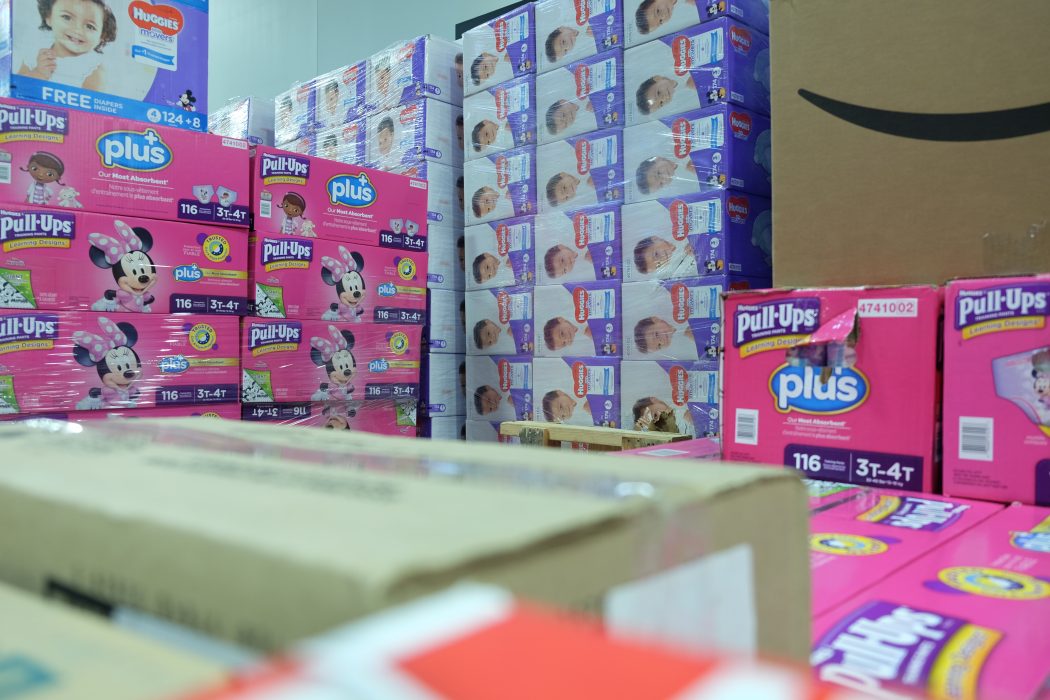
Thank you Sarah Pugh for taking the photos for this article! Without her help, this article would be very bland indeed.